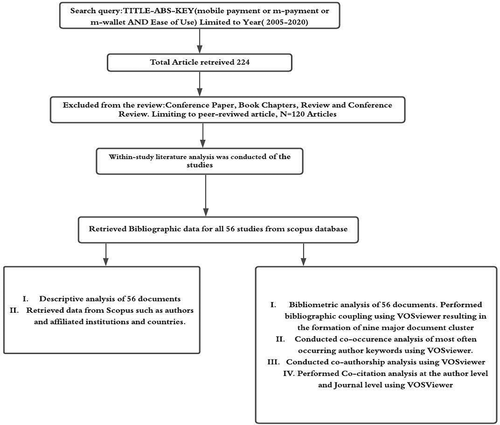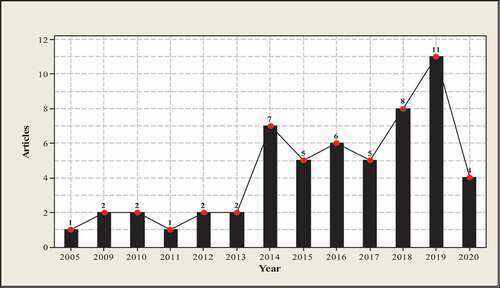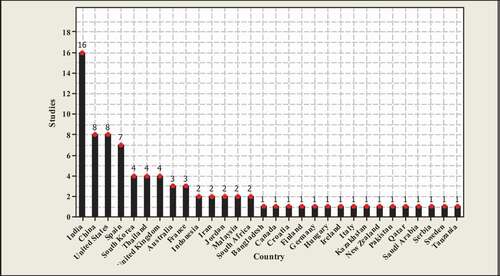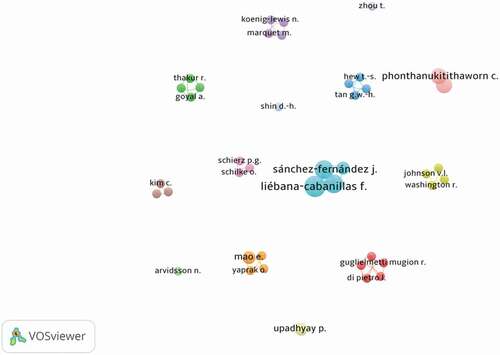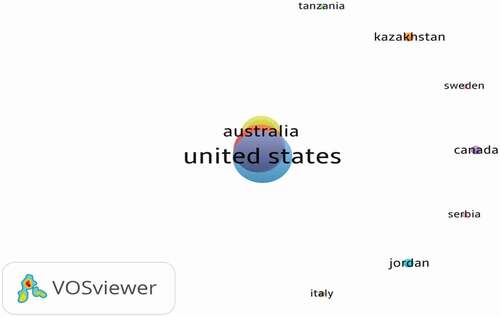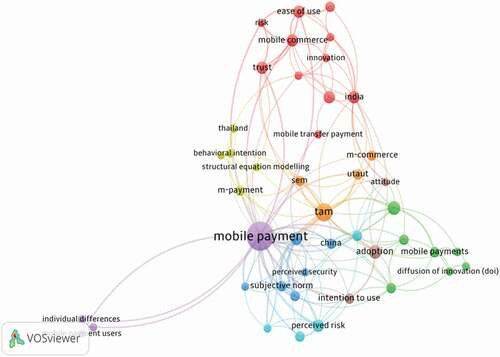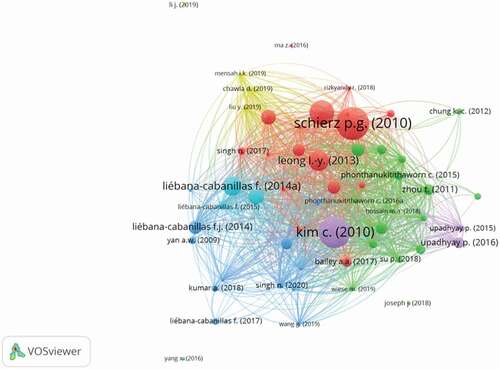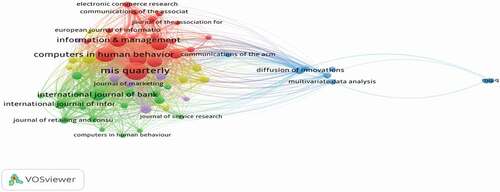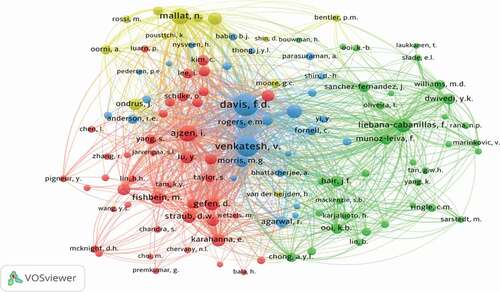Abstract
Scholarly interest in the field of m-payment has gained prominence in the last decade owing to the shift in consumer spending patterns. However, only limited numbers of review studies are available on the topic. To overcome the limitation, the paper comprehensively reviewed the content of existing literature available on m-payment to improve understanding of the current state of knowledge. The present research paper reviews peer-reviewed literature available in the Scopus database for the period 2005‑2020. A systematic literature search using the Scopus database was undertaken resulting in a total of 56 studies published in 44 peer-reviewed International journals. The present study reviews the publication trend in the field of m-payment, influential articles and most prolific and influential authors. Thereafter, a bibliometric analysis using VOS Viewer was carried out to identify thematic clusters. Construction of the network map using bibliographic coupling and co-citation analysis reveals interesting patterns and themes in the field of m-payment. Our study provides a better understanding of the field of m-payment and based on the results future avenues were proposed.
PUBLIC INTEREST STATEMENT
The present study is an attempt to contribute to the area of m-payment research and provides a comprehensive overview of the research undertaken in the field so far. Mobile payments have made massive strides over the last couple of months in the aftermath of the devastating effect of COVID-19 on economies and have kept the economies alive to ensure business continuity amidst restriction on movement and simultaneously re-inventing the wheel of the economy from the economic fallout. The present study uses a combination of systematic literature review and bibliometric analysis which helps in identification of the intellectual structure of the research area. The analysis presented in this paper would help in the development of shared understanding about the field of m-payment which could possibly in the near term help the practicing academicians, corporate and other stakeholders alike to potentially harness the benefits from the work of renowned authors and in particular approach the research institutions for the purpose of policy making.
1. Introduction
Technological innovations in the field of payments have revolutionized the payment ecosystem. Globally, payment ecosystems are undergoing through a phase of transition and have emerged as being the most innovative and cost effective technologies. Digital payments have become a catalyst of change by impacting our daily lives, society, business and the economy at large. Globally, COVID-19 pandemic has bring in a behavioural shift in consumer spending patterns and is driving the surge toward digital payment adoption (Capegemini, Citation2020). COVID-19 pandemic has fostered the adoption of digital payments method. Consumers and merchants are largely embracing digital payments to limit in-person transaction, making it less likely for the virus to spread through social contacts. Regulators across the globe are moving toward digital payments to ensure business continuity amidst restriction on movement and simultaneously re-inventing the wheel of the economy from the economic fallout. Payment industry is largely witnessing the influx of the fintech players and in the process making the payments more personalized, quick, simple, secure and seamless. Fintech players have captured millions of digital consumer by offering them cash-back rewards and discounts. According to the World Payments Report, 2019 India’s digital payments sector has witnessed an upsurge in recent years aided by easy access to smartphone, infrastructure upgrades and favorable regulatory support (Capegemini, Citation2019) . As per the report titled “India Internet 2019” the number of active internet users in India stands at 451 million (Nielsen Holdings, Citation2019) . According to a report by Worldline titled “India Digital Payments Report 2019” Unified Payment Interface (UPI) emerged as having the most preferred mode of payment (Worldline, Citation2019). The report further highlighted that transaction done through UPI were 214% higher than the previous year 2018. M-payment services due to its convenience and easy to use interface have grown significantly in India in the past few years (Singh et al. Citation2017) . Demonetization of the specified banknotes and the subsequent Government policy of Digital India have fostered the adoption of mobile-based payment solution. The Faster Payment Innovation Index of Fidelity National Information Services recognized India as having the most evolved digital payment system among the 25 Countries that were evaluated (FIS, Citation2018). Further, the report also highlighted that developments are compelling the payment service providers to offer personalized, seamless and user centric experience.
2. Literature review/background
Literature review reveals the research gaps inherent in the field of study and help the researchers to further investigate the research area previously unexplored. A variety of methods to review literature have been used by the academicians such as systematic review, scoping review, meta-analysis and weight analysis for publishing state of the art literature reviews. The present study employed a combination of systematic literature review (SLR) and Bibliometric analysis techniques to comprehensively overview the field of study which collectively helped in facilitating in identification of the intellectual structure. Mobile payment includes all those transactions conducted electronically, independent of time and place, using a cell phone and cellular network for transferring goods, services or information among two parties (Nambiar et al., Citation2004). Technological developments in the area of payment ecosystem have changed consumer’s lives significantly and provided them with the speed, convenience, choice and savings. The trend of mobile payment in India is on upward trajectory. Chhonker et al. (Citation2018) conducted a comprehensive review of the literature in the field of mobile commerce. The review was based on 184 empirical articles published between 2008 and 2017. The data for this review were collected through Scopus and Google scholar database. The researcher’s explored the relationship among the constructs using association rule mining and community detection algorithm. Liu et al. (Citation2019) conducted a meta-analysis to identify the factors affecting consumer behaviour towards mobile payment. Their meta-analysis was based on 61 papers published between 2008–2017. The study used web of science core collection database for retrieval of research papers. The findings of the study highlighted the place as a meta-factor, which in the opinion of the author’s is an important factor in consumer’s behavioural adoption of mobile payment. Dahlberg et al. (Citation2015) assessed the progress of mobile payment research using the porter five forces model framework. The review was based on 188 articles published between 2007 and 2014. The study provided a comparative analysis of the studies published prior and post 2007 research publication. The author scanned multitude of online databases and conferences to arrive at the requisite numbers of research papers for the purpose of study. Based upon their comparative analysis, they offered useful insights and recommendations for the mobile payment research community. De Albuquerque et al. (Citation2014) conducted a comprehensive scoping study of 94 peer-reviewed papers published between 2001 and 2011.The study used multitude of databases for retrieval of research papers and conducted a consultation exercise with key stakeholders to validate the findings of their scoping study. The study revealed the conceptual, methodological and geographical gap inherent in the field of m-payment. Previously, Mallat (Citation2007) conducted a qualitative study on Finnish consumer to explore the adoption of m-payments. The findings of the study highlighted the relative advantage as well as the barriers associated with the usage of mobile payments. The overarching aim of our study is to provide a comprehensive overview of the research published in the field of m-payment during 2005–2020. The present study addresses the following research questions:-
To identify the dynamics of research literature production?
To identify the most prolific and influential authors in the field of study?
To identify the most influential work in the field of study?
To identify the patterns of co-operation among authors and countries?
To identify the common theme of research flowing among researchers in the field of study?
To determine the periodic progression of m-payment research and the intellectual structure of research in this area?
3. Research methodology:-
The present study employed SLR as the process involving its conduct is structured, replicable, transparent and iterative in nature. Furthermore, it provides an objective basis for elimination of the studies that are not of interest to the author. Previously, Tranfield et al. (Citation2003) emphasized that traditional reviews does suffer from the subjectivity of the authors. Wider availability of the electronic databases makes it easier for researchers to carry out systematic research in a timely manner. The present study is a combination of SLR and Bibliometric analysis. First, we executed the SLR by inputting the required keyword in the Scopus database and later on systematically extracted the sample set of research papers using the inclusion and exclusion criteria. The present SLR was further facilitated with the help of within-study literature analysis as this analysis examines the entire content of a research paper. The premier sources of research papers for our present study were accessed from Scopus database. Scopus is the largest abstract and citation database of peer-reviewed literature and consists of articles from leading publishers. Keyword search is an appropriate way for finding out the article relevant for the purpose of study (Almeida, Citation2018; Kaushik & Rahman, Citation2014). The search string used in the Scopus—Title, abstract, keyword database was a combined search to generate the most relevant study in our research area. In the second stage, we performed bibliometric analysis of the literature on m-payment to help understand the intellectual structure of the research field. Previous research studies used variety of software to carry out bibliometric analysis. For our present study, we have used VOS Viewer because of its ability to display larger bibliometric maps in an easy-to-interpretable way which was not possible with the previous bibliometric software. Moreover, the software offers the added functionality for zooming, scrolling, and searching, which largely facilitates in the detailed examination of a map. . represents the design of the study.
Scope of the study: The present study comprehensively reviewed the empirical studies published in peer-reviewed journals from the year 2005–2020 using the Scopus database.
Selection Criteria: In selecting the articles for the purpose of review, we included only empirical article published in peer-reviewed journals and available in English language. We excluded the article published as conferences papers and conference reviews and book chapters. We further excluded the articles that were not available as full text article and outside the scope of the present study. provides a synoptic overview of the selection criteria undertaken by researcher for selection of relevant studies.
Table 1. Inclusion and Exclusion Criteria
The researcher exercised due care in storing the extracted data. Extracted data were imported in the form of .csv format and bibtex format and stored in the Mendley library for later analysis. In addition to, we stored a copy of selected articles to the Scopus saved list folder, so that it can later be used for bibliometric analysis. In the subsequent section, bibliographic data obtained from Scopus database are presented and analyzed through open source R-package.
4. General descriptive statistics
4.1. Main information regarding the collection
140 authors have written a total number of 56 articles spanning across various discipline such as Business and management, computer science, engineering, energy, environment, psychology, arts and humanities etc., and published in 44 reputed peer-reviewed journals. Collaboration amongst author is on the rise as 136 authors have multi-authored the research papers. Out of the total 56 articles, 4 research papers are single authored. The collaboration index of authors stands at 2.62. The value of documents per author is 0.4 and the value of author per documents is 2.5, respectively. Bibliometric analysis was specifically carried out using Bibliometrix, an open source software written in R-package (Aria & Cuccurullo, Citation2017). Descriptive analysis has been enumerated in :-
Table 2. Descriptive Information about Scientific papers retrieved
4.2. Publication trends in the field of m-payments
shows the number of annual publications on m-payment. The earliest research work in the field of m-payment dates back to the year 2005 and appeared in the Journal of Global Information Technology Management (Mao et al., Citation2005).
Interestingly, the research paper was an earlier attempt to empirically validate the adoption of mobile phone service behaviour among U.S. and Turkey citizens using extended Technology acceptance model. Research work in the field of m-payment was stagnant till the year 2013. From 2014 onwards, m-payments seemed to have caught the attention of the practicing scholars and the output in terms of research articles have improved significantly. The number of annual publications started to pick up momentum from the year 2014 and still continues. The annual scientific production growth rate is about 12.25% indicating a steady growth rate. Review of the publication trends highlighted that majority of research work is concentrated within the realm of developing countries such as India and China as both these countries have witnessed significant change in their digital payment ecosystem. Moreover, both these nations witnessed a significant surge in digital transaction in a short span of time owing to the Government and industry stakeholder constant push towards cashless transaction and cash-lite economy. Eyeballing of the data () suggest that out of the 30 most productive country, India emerged as a country with the highest number of research publications (n = 16), followed by China (n = 8) and the U.S. (n = 8). Post demonetization of the legal currency, the fintech companies in India offered innovative mobile payment solutions, cash-back, rewards and a robust technological infrastructure which led the practicing scholars to examining m-payment adoption in India (Bagla & Sancheti, Citation2018; Chawla & Joshi, Citation2019; Joseph et al., Citation2018; Kumar et al., Citation2018; Kumar & Arun Palanisamy, Citation2019; Malik et al., Citation2019; Parijat Upadhyay & Jahanyan, Citation2016; Shankar & Datta, Citation2018; Shaw & Kesharwani, Citation2019; Singh et al. Citation2020, Citation2017). Moreover, in terms of citation, publications originating from U.S.A as having the highest number of citations (n = 1014), followed by Spain (n = 362) and Korea (n = 254). On the contrary, publications originating from India and China are not yet able to generate much impact in terms of citations provided that journals in the areas of management and business research typically require long years to building citations (Fahimnia et al. Citation2015). Moreover, the concept of m-payment is relatively new in Indian context. An eyeballing of the research work published in the reputed journals highlighted the dominance of the quantitative research techniques. Researchers have contributed more towards empirical papers by adapting the constructs from previous studies resulting in a large number of empirical studies. A large proportion of research studies have been published in peer-reviewed International journals that have their jurisdiction in western countries which largely are homogenous in nature.
4.3. The most prolific and influential author
Prolific authors are the ones that created volumes of work and contribute towards the growth and advancement of a research field. Rey-Martí et al. (Citation2016) argued that knowledge of prolific authors in a particular domain is of paramount importance and they could possibly be approached for research and policy formulation in a specific field. Many authors have made significant contributions in the area of m-payment research. presents the most productive author in the area of m-payment research. Of all the 140 authors, that have contributed towards literature on m-payment, it is interesting to note that Liébana-Cabanillas, F. Muñoz-Leiva, F., Sánchez-Fernández., from Spain have emerged as most prolific and influential authors. For the purpose of inclusion in our study, criteria of two paper published by individual author was a benchmark criteria.
Table 3. Most productive Authors in the field of m-payment(2005–2020)
A synoptic overview of the prolific author highlight the fact that a majority of them have been affiliated to the University situated in Spain, followed by Institutes/Universities situated in India and the U.S, Australia, Thailand and Qatar. The prolific authors have contributed towards the field of study by publishing and propagating their research work in leading international journals.
4.4. Most influential works
Analysis of the prolific author provided key insight about the author’s contribution and their influence in the field of research. In addition to, it was deemed important to identify the highly cited research articles that have provided new avenues to the field of research. Total citations per year compare the influence of the article irrespective of the year in which it was published. To locate the most the most influential articles published in the field of m-payment, we set the cut-off limit to 50 citations. represents the list of highly cited papers on m-payment, published in reputed peer reviewed journals. The phenomenon of Matthew effect, whereby researcher tends to cite scholarly article that are highly cited is clearly visible and is considered as a better source of information.
Table 4. Highly cited research papers on m-payment
Analysis of the highly cited papers highlight the fact that Schierz et al. (Citation2010) significantly contributed towards m-payment research with this seminal work. His contribution laid the foundation for empirical research works in the field of m-payment. In addition to, his work opened up new vistas of scholarly inquiry. Subsequent to his work, practicing scholars explored the field using established theoretical frameworks and some scholars even extended the established frameworks by developing and validating new constructs which they felt were largely missing in prior literature (Madan & Yadav, Citation2016). Furthermore, some scholars extended the methodological perspective by incorporating advance level of statistical analysis in their research work (Gbongli et al., Citation2019; Leong et al., Citation2013; Liébana & Lara, Citation2017; Upadhyay & Chattopadhyay, Citation2015; Yang & Sattayatham, Citation2016). The next highly cited article in the league have been contributed by Kim et al. (Citation2010). Their work examined the adoption behaviour among different category of m-payment users using user-centric factors and m-payment service characteristics. The m-payment service characteristics proposed are largely used across different studies on m-payment in conjunction with established theoretical frameworks. Highly cited research works does helped in attaining the theoretical development and methodological maturity as well as the popularity across various disciplines.
5. Bibliometric analysis
To graphically visualize the bibliographic data, we used VOS Viewer to analyze the network relation among different units of analysis. In our present study, we performed different types of analysis:—co-authorship, co-occurrence, bibliographic coupling and co-citation analysis.VOS Viewer was choosen for this study due to its ability to create a map based on network data, bibliographic data and text data and the flexibility to support all types of files. The file used for visualization purpose in VOS Viewer is in .CSV format which contains bibliographic information of the articles.
5.1. Co-authorship network analysis of author and countries
Co-authorship network represents the amount of collaboration between authors, organization and countries. Co-authorship results in synergistic effect. Moreover, collaborative research results in novel scientific output and better quality research papers. In general practice, researchers collectively participate and contribute towards the production of scientific article, which owing to the individual’s contribution results in greater quantity and quality of scientific output. The analysis was performed using VOSviewer. shows the co-authorship network of authors that have co-authored at least 1 research paper. In fixing the threshold limit, researchers must have co-authored at least 1 document and cited at least 50 times between 2005 and 2020. The analysis resulted in a total of 41 authors grouped under 14 clusters each clusters being represented by different colors. Liébana-Cabanillas, F. Muñoz-Leiva, F., Sánchez-Fernández., from Spain makes up the strongest co-authorship network with 4 co-authored documents. In addition to, Phonthanukitithaworn C. and Sellitto C. have co-authored 3 documents. presents the co-authorship network of author-affiliated countries having at least 1 publication between 2005 and 2020. In choosing the threshold limits, minimum of a 10 numbers of citations of a country was applied which resulted in a total of 21 countries. The USA emerged has having the highest total link strength among all the countries. There exist no linkages among the countries such as Tanzania, Kazakhstan, Sweden, Canada, Serbia, Jordan and Italy. On the other hand, there exist a strong Collaboration network among countries such as Germany, France, UK, USA, South Korea, Iran, Spain, Thailand, India, China and Australia.
5.2. Keyword co-occurrence network
To encapsulate the thematic flow of knowledge prevailing among researchers, author keyword analysis was carried out. Therefore, we have undertaken author keyword analysis to better understand the research trend prevailing in the field of m-payment. We used VOSviewer version 1.6.15 to generate keyword co-occurrence network. Initially, a total of 195 keywords from the list of 56 papers were extracted. In order to generate the co-occurrence network of most frequently used author keywords, the keywords were limited to at least two occurrences which resulted in a total of 45 keywords. Of the 195 keywords, 45 keywords met the threshold criteria. depicts the frequently used author keywords co-occurrence network. The map shows that “mobile payment” is largely studied concept, followed by “TAM”. The term mobile payment emerged as the widely used author keyword with 22 occurrences and followed by TAM with 9 occurrences. The analysis resulted in a total of 45 keywords grouped under 9 clusters, each cluster being represented by different color with total link strength of 209. Author keywords analysis offers some useful insight. First, it shows that traditional theoretical adoption models like TAM, UTAUT, and diffusion of innovation theory are largely adopted by researcher’s to generate theoretical model. These models have been used by researchers to examine/investigate the adoption intention/behavioural intention to use mobile payment. Second, it shows that theoretical constructs are used interchangeably across various studies and some studies even have used hybrid model to better investigate the issue of mobile payment adoption. Thirdly, it shows that scores of researchers have used Structural equation modelling as a preferred mode of statistical analysis to validate their proposed model and hypothesis. Fourthly, it shows that research works is largely concentrated to emerging and developing markets like India, China and Thailand as these nations have witnessed upsurge in adoption of m-payment in recent years.
5.3. Bibliographic coupling of documents:-
Kessler (Citation1963) put forward the concept of bibliographic coupling. Two articles are said to be bibliographically coupled when they refer to a common third work in their reference list. Increase in the number of references that two articles commonly refer to in their reference list, increases the strength of bibliographic coupling. Under bibliographic coupling, thematically similar documents are clubbed into clusters. Using VOS Viewer, 56 studies were grouped under six clusters. depicts the bibliographic coupling of documents. A brief overview of the clusters is provided below.
5.3.1. Cluster 1: Determinants of m-payment adoption
Cluster 1 in red color is the largest cluster with 17 documents cited 1221 times. Of the 56 studies under review, 17 research studies are grouped under 1st Cluster. The article in this cluster primarily focuses on determinants affecting intention to adopt m-payment services by consumers. The most cited articles in this cluster are by Schierz et al. (Citation2010) cited 454 times, followed by Shin (Citation2009) cited 254 times and by Leong et al. (Citation2013) cited 171 times, respectively.
5.3.2. Cluster 2: Users inclination towards m-payment adoption
This cluster contains 16 documents cited 422 times and is represented by green color. This cluster primarily investigates the user’s inclination towards the m-payment adoption. Of the 16 documents, Phonthanukitithaworn, C. delivered three research articles the maximum by any author in this cluster (Phonthanukitithaworn et al. Citation2015, Citation2016b, Citation2016a). The most cited article in this cluster are by Arvidsson (Citation2014) cited 68 times, followed by Johnson et al. (Citation2018) cited 53 times and Zhou (2011b) cited 51 times.
5.3.3. Cluster 3: Effect of innovativeness and technology readiness on intention to adopt and recommend m-payment services:-
This cluster contains 13 documents cited 148 times and is represented by sapphire blue color. This cluster primarily investigates the technology readiness and innovativeness on intention to adopt and recommend the m-payment services. The most cited articles in this cluster are by Di Pietro et al. (Citation2015) cited 53 times, followed by José Liébana-Cabanillas et al. (Citation2014) cited 78 times respectively. Di Pietro et al. (Citation2015)) study have emerged as a unique study in the clusters as it has examined the mobile ticketing adoption using integrated framework which includes constructs from the established theoretical model i.e DOI, TAM and UATAUT.
5.3.4. Cluster 4: Convergence of psychological elements, m-payment service characteristics and inhibiting factors to determine adoption and intention to use m-payment
Cluster 4 represented by yellow color contains 04 documents and cited only 15 times. It is one of weakest clusters in terms of citation generations. The articles in this cluster have not been able to generate much impact in terms of citations as they have been published recently in the year 2019. As Fahimnia et al. (Citation2015) argued that research works appearing in the journals that largely covers management and business research typically requires long years to building citations.
5.3.5. Cluster 5: Convergence of catalyst factors and m-payment service characteristics factors to augment the adoption of m-payment
Cluster 5 represented by 03 documents and has 485 citations. The article in this cluster primarily highlighted the adoption of catalyst factors that increases the adoption at large level. Kim et al. (Citation2010) work is the highly cited in this cluster.
5.3.6. Cluster 6: Determining adoption using moderation effect
Cluster 03 contains 03 documents cited 265 times and represented by blue color. The article in this cluster primarily aimed at determining adoption through different moderating variables such gender, age and experience. The most cited articles in this cluster is F. Liébana-Cabanillas et al. (Citation2014) cited 151 times. All articles in this cluster are authored by Liébana-Cabanillas.
5.4. Co-citation analysis at the journal level
Kumar (Citation2015) argued that co-citation is said to occur when the referring paper refers two documents simultaneously in its reference list. Co-citation analysis is used to study the intellectual structure of a research field from the perspective of cited publications. Co-citation is one of the effective tool for measuring the contextual similarity between two documents (Surwase et al. Citation2011). Co-citation analysis was performed using VOSviewer and was analyzed using full counting method. In order to generate a meaningful co-citation network, a threshold criteria of 10 minimum citations was employed, resulting in a total of 61 cited sources. Of the 1665 sources, 61 sources met the threshold criteria of 10 minimum citations. Co-Citation analysis of the cited sources resulted in the formation of five clusters represented by five different colors. shows the co-citation pattern of 61 sources cited at least 10 times by studies in our sample.
Cluster 1 (in red) contains 19 journals and it consists of wide variety of journals which include MIS quarterly, management sciences, information system research, electronic commerce research and application are the most cited journals in this cluster. Almost all journals are impact factor publication.
Cluster 2 (in green) contains 17 journals and is the second largest cluster. Most noted and impactful journals in this cluster includes Computers in human behaviour, decision support systems, information & management, journal of business research, journal of consumer marketing.
Cluster 3 (in blue) consists of 10 journals and includes diverse range of journals such as Communications of the acm, mis q and these journals are most cited in this cluster.
Cluster 4 (in Yellow) contains 8 Journals. Behaviour and Information technology, Industrial management & data system and expert systems with applications, journal of strategic information system are most cited journal in this category.
Cluster 5 (in purple) contains 7 journals. Decision sciences, European journal of marketing, journal of electronic commerce research are some of the noted journals in this field.
5.5. Co-citation analysis at the author level
Co-citation analyses at the author level were also performed. To be considered for inclusion, an author must have been cited 10 times. Analysis of co-citation patterns was also performed using VOSviewer using full counting method. Of the 4027 authors, 117 authors met the threshold criteria of 10 minimum citations. Co-Citation analysis of the cited authors resulted in the formation of four clusters depicted by four different colors. shows the co-citation pattern of 117 authors cited at least 10 times by studies in our sample. Cluster 1 (in red color) depicts the work of 43 highly cited authors and it is one of the largest clusters. Of all the 43 authors, Davis work titled “User acceptance of information technology: toward a unified view” emerged as the highly cited sources, followed by the work of Venkatesh, Ajzen, Bagozzi and Fishbein are the most cited authors in the field of mobile payment. Cluster 2 (in green) includes 11 authors. The most prominent authors in this cluster include Lu, Zhang and Zhou. Cluster 3 (in blue) includes 6 authors. In this cluster, Dahlberg, Mallat and Ondrus emerged as the most cited authors. Cluster 4 (in Yellow) includes 4 authors. The most prominent authors in this cluster consist of Liébana-Cabanillas Dwivedi and Ooi.
6. Research gaps in current research and direction for future research
After carrying out the exhaustive review of the literature, we identified that there has been continuous progress in the body of literature, there are major research gaps hampering the current research were identified. We propose some avenues for future research on m-payment.
6.1. Dominance of quantitative research
A large and growing body of literature has investigated the adoption behaviour/adoption intention using quantitative data and surveys. The review highlighted that considerable amount of research methods have been applied to examine the issue of m-payment in-depth. In a large number of studies, researchers have contributed more towards empirical papers by adapting the constructs from previous studies resulting in a large number of empirical studies. Researchers spanning across various disciplines used varied statistical techniques to analyze primary data Structural Equation Modelling is the widely used statistical technique by researchers, followed by Confirmatory factor analysis is the most used technique after SEM by researchers. Future researchers need to explore more advanced statistical techniques that can better predict the adoption intention of consumers.
6.2. Lack of studies on merchant adoption of m-payment:-
The present review highlights that majority of the studies examine the adoption of m-payments from consumer perspectives. To this date, there have been few empirical investigations into merchant acceptance of m-payment. In fact, very few researchers in the past have attempted to address the issue of merchant acceptance of m-payment which highlights the paucity of research on merchant acceptance of m-payment. Dahlberg et al. (Citation2008) emphasized that merchants participation is a key to secure large number of point of acceptance. Ligon et al. (Citation2019) emphasized that low rate of adoption among merchants is due to the demand side factor. Among the reason highlighted for non-adoption include consumer’s lack of enthusiasm to pay digitally, merchants concern for tax liability based on transaction done using m-payment and fear of being cheated. To overcome this gap, there is a need for more theory-based quantitative research to better understand the adoption intention of merchants.
6.3. Paucity of qualitative studies
The problem of lack of qualitative studies is inherent in the field of m-payment. Researchers have focused more towards empirical papers as data from consumer is easier and more convenient to collect. To this date, only Mallat (Citation2007) have examined customer adoption of m payment from qualitative perspective. This clearly highlighted that there exists a paucity of qualitative studies focusing different group of stakeholders. Future researchers must address this grave issue and give due emphasis on qualitative aspect.
6.4. Sampling limited to younger users
Together, these studies provide important insights into the growing interest towards younger users particularly more towards University and College level students as their sample sizes, which limits the generalisability of the findings for the entire population. Further research studies should take into account the adoption intention of people at various age levels and with different educational background.
6.5. Limited studies investigating moderating effect
Much of the current literature on m-payment examined the adoption intention, but only a limited number of studies investigated the moderation effect on intention to adopt (F. Liébana-Cabanillas et al., Citation2014; B. Shaw & Kesharwani, Citation2019; Su et al., Citation2018). A further study with more focus on moderation effect is therefore suggested to better predict the user intention to adopt m-payment.
6.6. Multi-country and cross-country cultural studies
Only a handful of studies have investigated the impact of culture on m-payment (Chung & Holdsworth, Citation2012; Mao et al., Citation2005). More work needs to be done to increase the reliability and validity of future cross cultural studies. In this contemporary era, when almost all the world economies are embracing digital payments for ensuring sustainability of their economies and the livelihood of their citizens, there is a pressing need for more cross-country studies to identify the factors driving adoption towards digital payments.
7. Discussion
In this section, we have capsulized our present study and presented the findings of the six research question that were mentioned in the introduction section. The findings with reference to six questions are enumerated below:
RQ (1) addresses the dynamics of research literature productions. From the findings, it can easily be deciphered that research on m-payment has started to pick up the momentum and this will see a rapid uptake especially in light of the havoc caused by novel corona virus. Last couple of years has witnessed significant contributions in the field of m-payment. Subsequent to 2013, research works have witnessed a dramatic shift as the researchers have propagated their work in leading peer-reviewed journals. Analysis of the country wise scientific production depicts altogether different story. The trend portrays an overall growing concentration of studies in the Asia-Pacific region (APAC), which largely includes major developing nations such as India and China. Countries in the APAC region are widely considered as a hotbed for innovative practices in the field of digitisation as it offers access to requisite talent, supportive business conditions which further stimulate growth and innovation.
The findings of RQ (2) highlighted the work of most prolific and influential authors in the field of m-payment. The analysis reports that Liébana-Cabanillas, F. Muñoz-Leiva, F., Sánchez-Fernández., from Spain have emerged as being the most influential researchers in this field with maximum number of scientific contributions.
The findings of RQ (3) highlighted that Schierz et al. work is one of the highly cited research work in the field of m-payment. Indeed, the research work propagated by Schierz was one of the earliest in the field of m-payment to have laid the foundation for the subsequent empirical work.
The findings of RQ (4) indicate the lack of co-operation among practicing countries and researchers. Author co-operation network indicates that researchers originating from the same geographical jurisdiction are more active in collaborative work and it is resulting in synergistic effect, leading to better academic output. Cooperation network of author affiliated country portrays the lack of networking among countries that are actively undertaking research in the field of m-payment.
To address our RQ (5), we used Keyword analysis which helps us to determine the common theme of research flowing among researchers in the field of m-payment. It shows that traditional information system research model is widely used model by researchers and the variables therein are used interchangeably to better predict the user adoption intention. Furthermore, a vast majority of researchers are using SEM as a preferred way to validate their proposed models. In addition, it also portrays the growing concentrations of research work in developing economies.
To address our RQ (6), we constructed the network map using bibliographic coupling and co-citation analysis based on bibliographic data analyzed in VOSviewer and it reveals interesting pattern and themes in the field of m-payment and the emergence of several clusters helps in the identification of the intellectual structure of the research area.
8. Conclusions and direction for future research
To the best of our knowledge, our study is a pioneering one to carry out the review in the field of m-payment using SLR and bibliometric analysis. The results of our study showed that research in the field of m-payment has been have been on an upward trajectory and researchers spanning across various jurisdiction, discipline’s and institutes are propagating their research work in leading peer-reviewed journals. Analysis of the country-wise scientific production reportedly highlighted that research works from the U.S emerged as having more influential in terms of citations, but lacks periodic progression. On the contrary, India and China have witnessed quantum jump in research works on account of growing popularity of low cost modes of digital payment in their economies. A synoptic overview of the peer-reviewed literature highlights the growing dominance of the quantitative methodologies adopted by researchers. Analysis of the co-authorship or scientific collaboration network reveals the growing convergence of research among selected authors and countries. Moreover, the network reveals that authors and countries are not well connected to each other. The present study should be viewed in light of the following limitations. The present study literature is restricted to Scopus database only and excluded conference publication, editorial, book chapters from further review. Future researchers must expand the scope of the present study by accessing several different databases such as Web of Science, Google scholar, Proquest, IEEE Explore, Dimensions API and ABI/Inform so as to overcome the limitations associated with the present study. Another limitation associated with the present study is that it reviewed the adoption studies from consumer perspective. Therefore, future studies must take into account the adoption of m-payment by different stakeholders. Present research work has also been characterized by limited search strategy which in itself is inherent limitation. Future research studies could use manual keyword search to locate appropriate studies on existing literature. The present study has used VOSviewer as a bibliometric tool to carry out various types of analysis. Future research study can expand the scope of the present study by utilizing others stated of art bibliometric tools such as Bib excel, HistCite and Gephi etc., for better visualization and comprehensive review. In addition to, future researcher’s can also use a variety of science mapping analysis software such as cite space, CiteNetExplore rand Sci2tool and SciMat to better represent the relationship among different units of analysis. Future research studies must address the issue of page rank analysis in order to distinguish between the popularity and prestige of a research paper. This would permit the examination in detail of the relevance of the citing papers and would help to locate the most prominent research paper in the field of study.
Despite the limitations mentioned above, our paper provides a comprehensive overview of the research on m-payment that would be of immense benefits to academicians and practitioners alike. This will help the extension and advancement of research on this topic.
Disclosure of statement
No potential competing interest was reported by the authors.
Acknowledgment
The author would like to thanks Prof. Mohammed Naved khan for his overall supervision for the research Paper. Furthermore, the author would like to convey sincere gratitude and thanks to Prof. Arpan Kar, Associate Professor, Department of Management Studies, Indian Institute of Technology-Delhi for the Valuable feedback and comments on the research paper during the 1st Online International Conference of Marketing on Marketing and Society (MARSOC-2020) Organised by Calcutta Business School from 20-25 July 2020. At last, the author would like to thanks Mr. Mohammad Umar Adil for his overall support.
Additional information
Funding
Notes on contributors

Abdullah
Abdullah is presently enrolled as a Full time Doctoral Candidate with the Faculty of Management Studies and Research, Department of Business Administration, Aligarh Muslim University, Aligarh, Pin-202001, Uttar Pradesh, India.
Mohammed Naved Khan is a Full time Professor at the Faculty of Management Studies and Research, Department of Business Administration, Aligarh Muslim University, Aligarh, Uttar Pradesh, India. Prof. Khan is the recipient of P D Agarwal TCI Award for Doctoral Research in Management under the aegis of IIM (Bangalore). He has also been awarded the prestigious “Emerald Literati Award (2018)” by Emerald Publishing Limited. He has teaching experience of more than 20 years and areas of interest include Marketing, Consumer Behaviour and Research Methodology. He has to his credit books published by leading publishers such as Sage Publications, New Delhi (India)/Thousand Oaks (USA)/London (UK). Around 90 of his research papers have been published in leading refereed national and international journals.
References
- Almeida, F. (2018). Canvas framework for performing systematic reviews analysis. Multidisciplinary Journal for Education, Social and Technological Sciences, 5(1), 65. doi:https://doi.org/10.4995/muse.2018.9832.
- Aria, M., & Cuccurullo, C. (2017). bibliometrix : an R-tool for comprehensive science mapping analysis. Journal of Informetrics, 11(4), 959–21. doi:https://doi.org/10.1016/j.joi.2017.08.007.
- Arvidsson, N. (2014). Consumer attitudes on mobile payment services - results from a proof of concept test. International Journal of Bank Marketing, 32(2), 150–170. doi:https://doi.org/10.1108/IJBM-05-2013-0048.
- Bagla, R. K., & Sancheti, V. (2018). Gaps in customer satisfaction with digital wallets: Challenge for sustainability. Journal of Management Development, 37(6), 442–451. doi:https://doi.org/10.1108/JMD-04-2017-0144.
- Capegemini. (2019). World Payments Report 2019. Capegemini. Retrieved from https://worldpaymentsreport.com/wp-content/uploads/sites/5/2019/09/World-Payments-Report-WPR-2019.pdf
- Capegemini. (2020). COVID-19 and the financial services consumer: Supporting customers and driving engagement through the pandemic and beyond. Retrieved from February 17, 2021, https://www.capgemini.com/in-en/wp-content/uploads/sites/6/2020/05/COVID-19-and-the-financial-services-consumer_V5-2.pdf
- Chawla, D., & Joshi, H. (2019). Consumer attitude and intention to adopt mobile wallet in India – an empirical study. International Journal of Bank Marketing, 37(7), 1590–1618. doi:https://doi.org/10.1108/IJBM-09-2018-0256.
- Chhonker, M. S., Verma, D., Kar, A. K., & Grover, P. (2018). m-commerce technology adoption: thematic and citation analysis of scholarly research during (2008-2017). Bottom Line, 31(3–4), 208–233. doi:https://doi.org/10.1108/BL-04-2018-0020.
- Chung, K.-C., & Holdsworth, D. K. (2012). Culture and behavioural intent to adopt mobile commerce among the Y generation: comparative analyses between Kazakhstan, Morocco and Singapore. Young Consumers, 13(3), 224–241. doi:https://doi.org/10.1108/17473611211261629.
- Dahlberg, T., Guo, J., & Ondrus, J. (2015). Electronic commerce research and applications a critical review of mobile payment research. Electronic Commerce Research and Applications, 14(5), 265–284. doi:https://doi.org/10.1016/j.elerap.2015.07.006.
- Dahlberg, T., Mallat, N., Ondrus, J., & Zmijewska, A. (2008). Past, present and future of mobile payments research: A literature review. Electronic Commerce Research And Applications, 7(2), 165-181. https://doi.org/https://doi.org/10.1016/j.elerap.2007.02.001
- de Albuquerque, J. P., Diniz, E. H., & Cernev, A. K. (2014). Mobile payments: A scoping study of the literature and issues for future research. Information Development, 32(3), 527–553. doi:https://doi.org/10.1177/0266666914557338.
- Di Pietro, L., Guglielmetti Mugion, R., Mattia, G., Renzi, M., & Toni, M. (2015). The Integrated Model on Mobile Payment Acceptance (IMMPA): An empirical application to public transport. Transportation Research Part C: Emerging Technologies, 56, 463–479. https://doi.org/https://doi.org/10.1016/j.trc.2015.05.001
- Fahimnia, B., Sarkis, J., & Davarzani, H. (2015). Green supply chain management: A review and bibliometric analysis. International Journal of Production Economics, 162, 101–114. doi:https://doi.org/10.1016/j.ijpe.2015.01.003.
- FIS. (2018). Flavors of Fast Report 2018. Retrieved from fisglobal.com/flavors-of-fast
- Gbongli, K., Xu, Y., & Amedjonekou, K. M. (2019). Extended technology acceptance model to predict mobile-based money acceptance and sustainability: A multi-analytical structural equation modeling and neural network approach. Sustainability (Switzerland), 11(13). doi:https://doi.org/10.3390/su11133639.
- Holdings, N. (2019). India Internet 2019. The Internet & Mobile Association of India (IAMAI). Retrieved from September 25, 2020, https://cms.iamai.in/Content/ResearchPapers/2286f4d7-424f-4bde-be88-6415fe5021d5.pdf
- Johnson, V. L., Kiser, A., Washington, R., & Torres, R. (2018). Limitations to the rapid adoption of M-payment services: understanding the impact of privacy risk on M-Payment services. Computers in Human Behavior, 79, 111–122. doi:https://doi.org/10.1016/j.chb.2017.10.035.
- José Liébana-Cabanillas, F., Sánchez-Fernández, J., & Muñoz-Leiva, F. (2014). Role of gender on acceptance of mobile payment. Industrial Management & Data Systems, 114(2), 220–240. https://doi.org/https://doi.org/10.1108/imds-03-2013-0137
- Joseph, J., Sriram, K. V., Rodrigues, L. L. R., Mathew, A. O., & Gana, K. C. (2018). An empirical study on customer adoption of mobile payment application in India. International Journal of Enterprise Network Management, 9(3–4), 363–375. doi:https://doi.org/10.1504/IJENM.2018.094675.
- Kaushik, A. K., & Rahman, Z. (2014). Perspectives and dimensions of consumer innovativeness: a literature review and future agenda. Journal of International Consumer Marketing, 26(3), 239–263. doi:https://doi.org/10.1080/08961530.2014.893150.
- Kessler. (1963). Kessler-1963-American_documentation. American Documentation, 14(1), 10–25. doi:https://doi.org/10.1002/asi.5090140103.
- Kim, C., Mirusmonov, M., & Lee, I. (2010). An empirical examination of factors influencing the intention to use mobile payment. Computers in Human Behavior, 26(3), 310–322. doi:https://doi.org/10.1016/j.chb.2009.10.013.
- Koenig-Lewis, N., Marquet, M., Palmer, A., & Zhao, A. (2015). Enjoyment and social influence: predicting mobile payment adoption. The Service Industries Journal, 35(10), 537–554. https://doi.org/https://doi.org/10.1080/02642069.2015.1043278
- Kumar, A., Adlakaha, A., & Mukherjee, K. (2018). The effect of perceived security and grievance redressal on continuance intention to use M-wallets in a developing country. International Journal of Bank Marketing, 36(7), 1170–1189. doi:https://doi.org/10.1108/IJBM-04-2017-0077.
- Kumar, A. S., & Arun Palanisamy, Y. (2019). Examining the consumers’ preference towards adopting the mobile payment system. International Journal of Electronic Finance, 9(4), 268–286. doi:https://doi.org/10.1504/IJEF.2019.104071.
- Kumar, S. (2015). Co-authorship networks: A review of the literature. Aslib Journal of Information Management, 67(1), 55–73. doi:https://doi.org/10.1108/AJIM-09-2014-0116.
- Leong, L.-Y., Hew, T.-S., Tan, G. W.-H., & Ooi, K.-B. (2013). Predicting the determinants of the NFC-enabled mobile credit card acceptance: A neural networks approach. Expert Systems with Applications, 40(14), 5604–5620. doi:https://doi.org/10.1016/j.eswa.2013.04.018.
- Liébana-Cabanillas, F., & Lara-Rubio, J. (2017). Predictive and explanatory modeling regarding adoption of mobile payment systems. Technological Forecasting And Social Change, (120), 32-40. https://doi.org/https://doi.org/10.1016/j.techfore.2017.04.002
- Liébana-Cabanillas, F., Sánchez-Fernández, J., & Muñoz-Leiva, F. (2014). Antecedents of the adoption of the new mobile payment systems: the moderating effect of age. Computers in Human Behavior, 35(December), 464–478. doi:https://doi.org/10.1016/j.chb.2014.03.022.
- Ligon, E., Malick, B., Sheth, K., & Trachtman, C. (2019). What explains low adoption of digital payment technologies? evidence from small-scale merchants in Jaipur, India. PLoS ONE, 14(7), 1–22. doi:https://doi.org/10.1371/journal.pone.0219450.
- Liu, Z., Ben, S., & Zhang, R. (2019). Factors affecting consumers’ mobile payment behavior: A meta-analysis. Electronic Commerce Research, 19(3), 575–601. doi:https://doi.org/10.1007/s10660-019-09349-4.
- Madan, K., & Yadav, R. (2016). Behavioural intention to adopt mobile wallet: A developing country perspective. Journal of Indian Business Research, 8(3), 227–244. doi:https://doi.org/10.1108/JIBR-10-2015-0112.
- Malik, A., Suresh, S., & Sharma, S. (2019). An empirical study of factors influencing consumers’ attitude towards adoption of wallet apps. International Journal of Management Practice, 12(4), 426–442. doi:https://doi.org/10.1504/IJMP.2019.102534.
- Mallat, N. (2007). Exploring consumer adoption of mobile payments – A qualitative study. 16(4), 413–432. doi:https://doi.org/10.1016/j.jsis.2007.08.001.
- Mao, E., Srite, M., Thatcher, J. B., & Yaprak, O. (2005). A research model for mobile phone service behaviors: empirical validation in the U.S. and Turkey. Journal of Global Information Technology Management, 8(4), 7–28. doi:https://doi.org/10.1080/1097198X.2005.10856406.
- Nambiar, S., Lu, C. T., & Liang, L. R. (2004). Analysis of payment transaction security in mobile commerce. In proceedings of the 2004 IEEE international conference on information reuse and integration, IRI-2004. https://doi.org/https://doi.org/10.1109/iri.2004.1431506
- Phonthanukitithaworn, C., Sellitto, C., & Fong, M. (2015). User intentions to adopt mobile payment services: A study of early adopters in Thailand. Journal of Internet Banking and Commerce, 20(1), 29. https://www.scopus.com/record/display.uri?eid=2-s2.0-84939549352&origin=resultslist&sort=plf-f&src=s&st1=&st2=&sid=eafb23929e1a0b013344d47cfed4b173&sot=b&sdt=b&sl=102&s=TITLE-ABS-KEY%28User+intentions+to+adopt+mobile+payment+services%3a+A+study+of+early+adopters+in+Thailand%29&relpos=0&citeCnt=33&searchTerm=
- Phonthanukitithaworn, C., Sellitto, C., & Fong, M. W. L. (2016a). A comparative study of current and potential users of mobile payment services. SAGE Open, 6(4), 4. doi:https://doi.org/10.1177/2158244016675397.
- Phonthanukitithaworn, C., Sellitto, C., & Fong, M. W. L. (2016b). An investigation of mobile payment (m-payment) services in Thailand. Asia-Pacific Journal of Business Administration, 8(1), 37–54. doi:https://doi.org/10.1108/APJBA-10-2014-0119.
- Rey-Martí, A., Ribeiro-Soriano, D., & Palacios-Marqués, D. (2016). A bibliometric analysis of social entrepreneurship. Journal of Business Research, 69(5), 1651–1655. doi:https://doi.org/10.1016/j.jbusres.2015.10.033.
- Schierz, P. G., Schilke, O., & Wirtz, B. W. (2010). Understanding consumer acceptance of mobile payment services: An empirical analysis. Electronic Commerce Research and Applications, 9(3), 209–216. doi:https://doi.org/10.1016/j.elerap.2009.07.005.
- Shankar, A., & Datta, B. (2018). Factors affecting mobile payment adoption intention: an indian perspective. Global Business Review, 19(3_suppl), S72–S89. doi:https://doi.org/10.1177/0972150918757870.
- Shaw, B., & Kesharwani, A. (2019). Moderating effect of smartphone addiction on mobile wallet payment adoption. Journal of Internet Commerce, 18(3), 291–309. doi:https://doi.org/10.1080/15332861.2019.1620045.
- Shin, D.-H. (2009). Towards an understanding of the consumer acceptance of mobile wallet. Computers in Human Behavior, 25(6), 1343–1354. doi:https://doi.org/10.1016/j.chb.2009.06.001.
- Singh, N., Sinha, N., & Liébana-Cabanillas, F. (2020). Determining factors in the adoption and recommendation of mobile wallet services in India: Analysis of the effect of innovativeness, stress to use, and social influence. International Journal Of Information Management, (50), 191-205. https://doi.org/https://doi.org/10.1016/j.ijinfomgt.2019.05.022
- Singh, N., Srivastava, S., & Sinha, N. (2017). Consumer preference and satisfaction of M-wallets: A study on North Indian consumers. International Journal of Bank Marketing, 35(6), 944–965. doi:https://doi.org/10.1108/IJBM-06-2016-0086.
- Su, P., Wang, L., & Yan, J. (2018). How users’ Internet experience affects the adoption of mobile payment: A mediation model. Technology Analysis and Strategic Management, 30(2), 186–197. doi:https://doi.org/10.1080/09537325.2017.1297788.
- Surwase, G., Atomic, B., Sagar, A., Atomic, B., Kademani, B. S., Atomic, B., & Bhanumurthy, K. (2011). Co-citation Analysis : An Overview ISBN : 935050007–8, (September).
- Thakur, R., & Srivastava, M. (2013). Customer usage intention of mobile commerce in India: an empirical study. Journal Of Indian Business Research, 5(1), 52–72. https://doi.org/https://doi.org/10.1108/17554191311303385
- Tranfield, D., Denyer, D., & Smart, P. (2003). Towards a methodology for developing evidence-informed management knowledge by means of systematic review. British Journal of Management, 14(3), 207–222. doi:https://doi.org/10.1111/1467-8551.00375.
- Upadhyay, P., & Chattopadhyay, M. (2015). Examining mobile based payment services adoption issues: A new approach using hierarchical clustering and self-organizing maps. Journal of Enterprise Information Management, 28(4), 490–507. doi:https://doi.org/10.1108/JEIM-04-2014-0046.
- Upadhyay, P., & Jahanyan, S. (2016). Analyzing user perspective on the factors affecting use intention of mobile based transfer payment. Internet Research, 26(1), 38–56. doi:https://doi.org/10.1108/IntR-05-2014-0143.
- Worldline. (2019). India Digital payments Report. Wordline. Retrieved fromAugust 20, 2020, https://worldline.com/content/dam/worldline/documents/india/documents/worldline-india-digital-payments-report-2019-a-year-in-review.pdf
- Yang, X., & Sattayatham, P. (2016). Based on neural network approach predicting mobile payment adoption inclination determinants in Southest Asia. Journal of Theoretical and Applied Information Technology, 87(1), 126–137. https://www.scopus.com/record/display.uri?eid=2-s2.0-84967239628&origin=resultslist&sort=plf-f&src=s&st1=&st2=&sid=2ba5e728fe867b74a27238db5414befe&sot=b&sdt=b&sl=124&s=TITLE-ABS-KEY%28Based+on+neural+network+approach+predicting+mobile+payment+adoption+inclination+determinants+in+Southest+Asia%29&relpos=0&citeCnt=1&searchTerm=
- Zhou, T. (2011). The effect of initial trust on user adoption of mobile payment. Information Development, 27(4), 290–300. https://doi.org/https://doi.org/10.1177/0266666911424075

